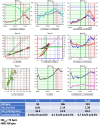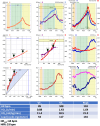Exercise intensity prescription in cardiovascular rehabilitation: bridging the gap between best evidence and clinical practice
- PMID: 39257844
- PMCID: PMC11383788
- DOI: 10.3389/fcvm.2024.1380639
Exercise intensity prescription in cardiovascular rehabilitation: bridging the gap between best evidence and clinical practice
Abstract
Optimizing endurance exercise intensity prescription is crucial to maximize the clinical benefits and minimize complications for individuals at risk for or with cardiovascular disease (CVD). However, standardization remains incomplete due to variations in clinical guidelines. This review provides a practical and updated guide for health professionals on how to prescribe endurance exercise intensity for cardiovascular rehabilitation (CR) populations, addressing international guidelines, practical applicability across diverse clinical settings and resource availabilities. In the context of CR, cardiopulmonary exercise test (CPET) is considered the gold standard assessment, and prescription based on ventilatory thresholds (VTs) is the preferable methodology. In settings where this approach isn't accessible, which is frequently the case in low-resource environments, approximating VTs involves combining objective assessments-ideally, exercise tests without gas exchange analyses, but at least alternative functional tests like the 6-minute walk test-with subjective methods for adjusting prescriptions, such as Borg's ratings of perceived exertion and the Talk Test. Therefore, enhancing exercise intensity prescription and offering personalized physical activity guidance to patients at risk for or with CVD rely on aligning workouts with individual physiological changes. A tailored prescription promotes a consistent and impactful exercise routine for enhancing health outcomes, considering patient preferences and motivations. Consequently, the selection and implementation of the best possible approach should consider available resources, with an ongoing emphasis on strategies to improve the delivery quality of exercise training in the context of FITT-VP prescription model (frequency, intensity, time, type, volume, and progression).
Keywords: cardiac rehabilitation; cardiovascular disease; cardiovascular health; exercise; exercise test; health; heart disease risk factors; physical activity.
© 2024 Milani, Milani, Verboven, Cipriano and Hansen.
Conflict of interest statement
The authors declare that the research was conducted in the absence of any commercial or financial relationships that could be construed as a potential conflict of interest. The reviewer HH declared a past co-authorship with the author DH to the handling editor.
Figures







References
-
- Uddin J, Zwisler AD, Lewinter C, Moniruzzaman M, Lund K, Tang LH, et al. Predictors of exercise capacity following exercise-based rehabilitation in patients with coronary heart disease and heart failure: a meta-regression analysis. Eur J Prev Cardiol. (2016) 23(7):683–93. 10.1177/2047487315604311 - DOI - PubMed
Publication types
LinkOut - more resources
Full Text Sources
Miscellaneous

